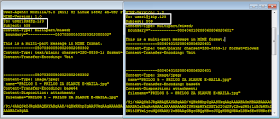03806.5 OE3XEC: Amsstetten AUT, 0754 WinLink traffic (23Oct16) (AAI)
05115.0 ---: Turkish Mil, TUR 0549 (cf) FSK 300Bd/400, KG-84C encrypted (24Oct16) (AAI)
05140.0 ---: Russian Mil (prob. AF) 0602 J3E/USB female voice comms (24Oct16) (AAI)
05182.0 ---: Unid 0722 R&S ALIS 228.65Bd/200 calling address 2190 (25Oct16) (AAI)
05210.0 BU4: Roumenian Police Bucuresti, ROU 0602 USB MIL 188-141 2G-ALE handshake TUL flwd by MIL 188-110A (19Oct16) (AAI)
05211.5 6GW0: Italian Mil, I 0647 J3E/USB radio-check with FB4T, 0WPF, Q77V, 3X0N, Q67Z (25Oct16) (AAI)
05258.0 J62: Moroccan Mil, MRC USB MIL 188-141 2G-ALE sounding (19 Oct16) (AAI)
05316.0 K1U: Slovakian AF, SVK 0637 USB MIL 188-141 2G-ALE calling Z1V (25Oct16) (AAI)
05316.0 P1O: Slovakian AF Prezov, SVK 0637 USB MIL 188-141 2G-ALE calling Z1V (25Oct16) (AAI)
05316.0 S1L: Slovakian AF, SVK 0637 USB MIL 188-141 2G-ALE calling Z1V (25Oct16) (AAI)
05316.0 Z1V: Slovakian AF Zvolen, SVK 0637 USB MIL 188-141 2G-ALE calling S1S (25Oct16) (AAI)
05340.0 LY01: Algerian Mil, ALG 0549 USB MIL 188-141 2G-ALE calling PY01 (26Oct16) (AAI)
05352.5 HG7BHB: propagation beacon, HUN 0545 CW "VVV DE HG7BHB QTH JN97LE 34SF PWR 50W" (24Oct16) (AAI)
05371.5 9A3WD1P: Global ALE HFnet 0630 USB MIL 188-141 2G-ALE sounding (22Oct16) (AAI)
05400.0 DG501D: French Navy, F 0737 USB 188-141 2G-ALE handshake DG401D flwd by STANAG-4285, KG-84C encrypted (20Oct16) (AAI)
05405.0 YK01: Algerian Mil, ALG 0551 USB MIL 188-141 2G-ALE calling PY01 (26Oct16) (AAI)
05410.0 3127: Sonatrach, ALG 0647 USB MIL 188-141 2G-ALE sounding (24Oct16) (AAI)
05415.5 ---: Russian Mil (prob. AF) 0710 J3E/USB female voice comms (24Oct16) (AAI)
05420.0 IU01: Algerian Mil, ALG 0634 USB MIL 188-141 2G-ALE calling JP01 (27Oct16) (AAI)
05424.0 5B: Bosnia Herzegovina Defense 5th Infantry Brigade Tuzla, BIH 0722 USB MIL 188-141 2G-ALE handshake 2PB flwd MIL 188-110A (24Oct16) (AAI)
05453.0 FP: prob.Italian Guardia Costiera, I 0645 J3E/USB stations: WW, EA, EB, EF, radio-checks, coded msgs as ADA,ASA,ASB,ATA,ANA,ATB using NATO phonetic, prob voice-net parallel to data-net (20Oct16) (AAI)
05455.0 RD21: Algerian Mil, ALG 0557 USB MIL 188-141 2G-ALE handshake PY20 flwd by 188-110A (25Oct16) (AAI)
05500.0 5555: Unid net 0610 USB MIL 188-141 2G-ALE calling 4444 [CMD AMD][/>A2001 ] (20Oct16) (AAI)
05792.0 2212: Unid net 0614 USB MIL 188-141 2G-ALE sounding (20Oct16) (AAI)
05813.5 DO7: Polish Mil, POL 0619 USB MIL 188-141 2G-ALE calling RA2 (26Oct16) (AAI)
05813.5 DO7: Polish Mil, POL 0621 USB MIL 188-141 2G-ALE calling PT1 (26Oct16) (AAI)
05813.5 WI5: Polish Mil, POL 0619 USB MIL 188-141 2G-ALE sounding (26Oct16) (AAI)
05850.0 BU4: Roumenian Police, ROU 0633 USB MIL 188-141 2G-ALE handshake TUL flwd by 188-110A transporting STANAG-5066 HBFTP msgs (24Oct16) (AAI)
05903.0 DO7: Polish Mil, POL 0621 USB MIL 188-141 2G-ALE handshake WI5 (26Oct16) (AAI)
05903.0 DO7: Polish Mil, POL 0627 USB MIL 188-141 2G-ALE calling TE6 (26Oct16) (AAI)
06450.0 ZOCCOLA: Guardia di Finanza, I 0720 USB MIL 188-141 2G-ALE handshake CAGLIARI, voice comms using callsigns ROSTRO549 (ALE ZOCCOLA) and SIRIO60 (ALE CAGLIARI): position, heading and speed of ROSTRO549 (27Oct16) (AAI)
06510.0 Z1V: Slovackian AF Zvolen, SVK 0633 USB 188-141 2G-ALE handshake P1O Prezov flwd by 188-110A transporting Stanag-5066 HBFTP msgs (20Oct16) (AAI)
06779.0 ---: Unid 0705 USB RFSM-8000 modem with data-masking (21Oct16) (AAI)
06806.0 ---: Unid 0845 USB MIL 188-141 2G-ALE using App.B Linking Protection (27Oct16) (AAI)
06905.0 BX02: Algerian Mil, ALG 0757 USB MIL 188-141 2G-ALE calling PY01 (22Oct16) (AAI)
06905.0 HN02: Unid (Algerian Military?) 0824 USB MIL 188-141 2G-ALE handshake BZ01, no traffic (27Oct16) (AAI)
06931.0 ---: Unid 0628 USB modified STANAG-4285 waveform (21Oct16) (AAI)
07316.0 ---: Russian Nvay, RUS 0615 (cf) CIS Navy "Akula" FSK 500Bd/1000 (25Oct16) (AAI)
07535.0 CP01: Algerian Mil, ALG 0541 USB MIL 188-141 2G-ALE calling PY01 (25Oct16) (AAI)
07656.0 ---: Russian Intel, RUS 0710 USB CIS FTM-4, MFSK-4 150Bd (effective 37.5Bd) 4000Hz modem (tones at: -6, -2, +2, +6 KHz) (26Oct16) (AAI)
07745.0 TBB: Turkish Navy Ankara, TUR 0520 USB STANAG-4285 600bps/L CARBs//TBB040I(0)/TBB041I(0)/TBB043I(0)/TBB045I(0)/TBB049I(0)/TBB050I(0)// (25Oct16) (AAI)
08950.0 83401: Turkish Emergency Net, TUR 2037 USB MIL 188-141 2G-ALE sounding (22Oct16) (AAI)
09095.0 ---: Unid (prob. Ukrainian net) 0522 USB 3 of 6x100Bd/120Hz VFT system (26Oct16) (AAI)
10168.0 ---: Unide 1229 USB Arcotel MAHRS-2400 ALE bursts (25Oct16) (AAI)
11155.0 RIT: Rus Navy HQ Severomorsk, RUS 0846 CW "RAL65 DE RIT QSA?" (23Oct16) (AAI)
11155.0 RIT: Rus Navy HQ Severomorsk, RUS 0857 CW "RKN64 DE RIT RIT QSA 2 QRV K" (23Oct16) (AAI)
11429.0 ---: Russian Intel, RUS 1045 (cf) MFSK-68 (34+34) + QPSK 2400Bd 10KHz wide-band inserts (25Oct16) (AAI)
11470.0 ---: Unid (prob. Russian Navy) 1315 FSK 50Bd/500, no traffic (25Oct16) (AAI)
13215.0 201067: USAF unid asset 1113 USB MIL 188-141 2G-ALE sounding (27Oct16) (AAI)
13220.0 ---: no call 1323 USB MIL 188-141 2G-ALE calling CHARLY46 Italian AF (46th Air Brigade) (27Oct16) (AAI)
13499.0 11021: Moroccan Civil Defence, MRC 1122 USB MIL 188-141 2G-ALE sounding (27Oct16) (AAI)
13499.0 2215: Moroccan Civil Defence, MRC 1108 USB MIL 188-141 2G-ALE sounding (27Oct16) (AAI)
13499.0 2415: Moroccan Civil Defence, MRC 1109 USB MIL 188-141 2G-ALE sounding (27Oct16) (AAI)
13505.0 ---: Unid 1120 USB STANAG-4538 LSU + LDL, Harris Citadel encryption (27Oct16) (AAI)
13538.0 ---: Russian Mil, RUS 1213 USB CIS-45 OFDM HDR modem v2 BPSK 40Bd 62.5Hz (23Oct16) (AAI)
13554.0 CENTR3: MAECT Bucarest Centrala3, ROU 1047 USB MIL 188-141 2G-ALE handshake BLJ Telaviv Embassy, flwd by 188-110A transporting STANAG-5066 messages (27Oct16) (AAI)
14493.0 RGG: Russian Mil, RUS 1134 CW "RGP RGP RGP DE RGG RGG QSY 14653 QSY 14653" (21Oct16) (AAI)
14581.5 ---: Russian Navy, RUS 1330 FSK 50Bd/40, 7-bit code 4/3 (four 1 + three 0) (23Oct16) (AAI)
14968.0 XSS: DHFCS Forest Moor, G 1337 USB MIL 188-141 2G-ALE calling XDV (22Oct16) (AAI)
16000.0 6207: Unid 1213 USB MIL 188-141 2G-ALE calling 6202 (26Oct16) (AAI)
16103.0 Russian Mil, RUS 1244 USB CIS-112 OFDM modem 22.22Bd BPSK (24Oct16) (AAI)












































